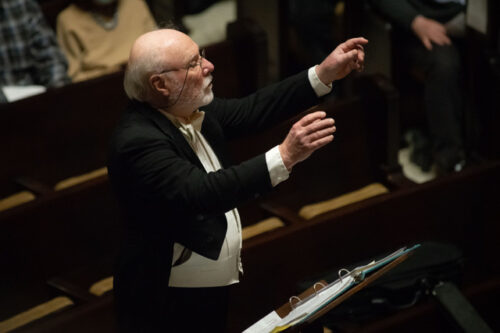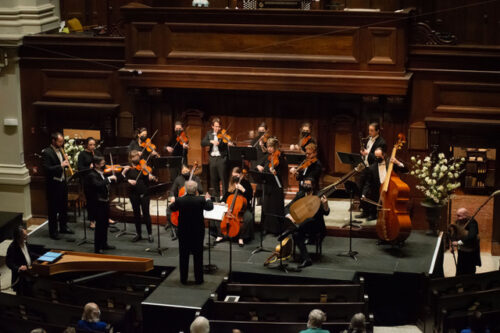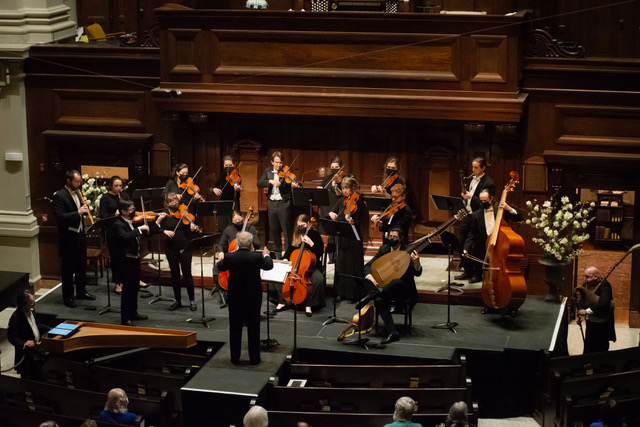 United States Telemann: Early Music New York / Frederic Renz (director). First Church of Christ Scientist, New York, 7.5.2022. (RP)
United States Telemann: Early Music New York / Frederic Renz (director). First Church of Christ Scientist, New York, 7.5.2022. (RP)

Telemann – Polish Dances from the Rostock Manuscript TWV 45; Quatour (with interpolations) TWV 43:B3; ‘Concerto Polonaise’ in G major TWV43:G7; ‘Sinfonia melodica’ in C major TWV 50:2; ‘Sonata Polonaise’ TWV 42:a8; Ouverture (composite, à la Polonaise)
Georg Philipp Telemann spent only one year in Poland, but the exotic sounds (he termed them barbaric) that he heard there inspired him to compose music that was distinctive and daring at the time. In ‘Telemann à la Polonaise – from folk to formal’, Early Music New York, under the direction of Frederic Renz, performed Telemann works influenced by the style and spirit of the music which so captivated the composer.
Telemann was 25 years old when he entered the service of Erdmann II, Count von Promnitz, as Kapellmeister at his court in Żary (formerly Sorau) in Upper Silesia. Eager and adept at incorporating different national styles into his music, the sounds that Telemann heard in Polish taverns provided the inspiration for any number of works. It was not only the Polish music he heard on visits to Krakow that caught his ear, but also dances from the Hana region of Moravia, the eastern part of present-day Czechia, which lies close to the Polish border.
Sounds that were exotic in aristocratic courts of the eighteenth-century are less so to present-day audiences: dances such as Polonaises and mazurkas have become intertwined in the fabric of Western music. Credit for this goes in no small part to Chopin, whose piano compositions a century later drew heavily from Polish dances. The Moravian hànaks, with their repeated rhythmic patterns, unison textures and bass drones, are now somewhat familiar as composers in the late seventeen and eighteenth centuries occasionally used them in their instrumental works in lieu of the customary, and more proper, minuet.

Renz and his troupe are not only superb musicians, but they also have a theatrical flair. The concert began with Wayne Hankin entering from the rear of the church playing the Grosser Bock, an Eastern European type of bagpipe. The sound is mellower than that of the Scottish or Irish bagpipe, and visually Hankin’s bock was extraordinary, with a massive cow horn jutting from the end of the drone. He and his instrument would have been right at home in Mel Brooks’s 1974 comedy/horror film, Young Frankenstein.
Hankin was soon joined by concertmaster Daniel S. Lee playing a tiny fiddle, known as the kit or pochette (which is particularly associated with dance music), in selections from the Rostock Manuscript. This collection of 31 folk tunes, notated only for melody and bass, was discovered in 1986. Later in the program, Lee and Hankin (this time paying a much smaller bagpipe, the cornemuse which originated in France) were joined by bassoonist Benjamin Matus in more Polish dances. The bassoon’s sound added bite to the music, while Matus’s jauntiness made them all the livelier.
Telemann quipped that to accommodate the taste of his aristocratic listeners, it was necessary for him to clothe the foreign sounds ‘in an Italian dress’. This was especially evident in the ‘Concerto Polonaise’ in G major in which the German composer seemed to channel Vivaldi, albeit with a distinctly Polish flair. In this work, as they did so often during the concert, the strings played with a transparent sheen that was the musical equivalent of the clearest glass and lovely beyond measure. Playing of such refinement would surely have passed muster with the most discerning of Telemann’s audiences.
In the ‘Sonata Polonaise’, Telemann superimposed a typical four-movement Italian form upon decidedly non-Italianate sounding music. The movements may be entitled Andante, Allegro and the like, but the sounds and rhythms are Polish. It was a virtuoso showpiece for Daniel S. Lee, who was joined by principal violist Dan McCarthy and principal cellist Sarah Stone in some notably lively and colorful music making.
Telemann’s ‘Sinfonia melodica’ for two oboes, strings and continuo was the only work performed that was not inspired by the sounds that the composer had heard in Poland. Dating from 1767, the suite is composed of familiar dance forms such as the minuet, sarabande, chaconne and gigue. It featured the superb playing of oboists Andrew Blanke and Caroline Gassi, who produced trumpet-like tones that were as intriguing as they were beautiful.
The sole encore was a Hanasky, the last movement of Telemann’s Ouverture in E major TWV 55: E1. In this brief work, Telemann distilled all of the sounds and rhythms that so intrigued him into one delightful musical whirlwind. Few concerts are as much fun as this one was, made all the more special by the sense of style, impeccable technique and delight which Renz and his troupe of musicians brought to each work they played. The music made you want to dance.
Rick Perdian
